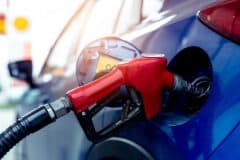What is the Price Difference for Regular or Premium Fuel and Which is Best?
The trending price of regular-grade gasoline in California is $4.67 per gallon, on average. The current premium-grade average cost here is $4.98. The price of an average gallon of gas in American right now is $3.31 a gallon (an average of all grades combined).
Those cost figures underline the latest in our auto tips: premium grade costs notably more than regular, and gasoline in general costs a lot more in California than it does in much of the rest of the country.
In other words, now might be the time for California drivers to figure out for sure whether their vehicles need premium grade and how the more expensive grade might benefit their rides (or not).
California drivers tend to spend a lot of time on the road. Understanding how much different things that affect your vehicle cost, like car insurance, maintenance and fuel, is important.
So let’s get started.
Why Does it Matter Whether I Burn Premium or Regular Grade Gas in California?
Cost. The ability to save on fuel in California is one of the biggest reasons drivers give for choosing regular rather than premium. Other issues include engine performance and fuel economy, and we’ll get to those factors soon.
In these inflationary times, every move you make that can reduce your outflow of dollars might be worth considering. While the price difference between regular and premium fuel is more than $0.30 a gallon per the latest AAA price report, in the recent past, the difference has averaged as much as $0.63 a gallon. Let’s roughly split the difference and call it a $0.50 price differential.
If your vehicle holds 15 gallons and you fill up with premium at every gas station stop, you’ll spend about $7.50 more per tank for the fuel luxury. Or save that much if you switch to regular.
To save on fuel in California, your best move is to only pump regular gasoline. Open and shut case, right? Maybe, but let’s hear the whole story.
So Why Does Anyone Put Premium Grade Gas in Their Tank?
People just love to waste money. There can’t be any other reason to put the pricey stuff in your tank. Right?
Not quite. There’s engine performance and fuel economy to consider, and premium takes the lead here. It’s up to you to determine how important those factors are against cost and quality realities.
Let’s break for a brief introduction to octane. That’s one of those words that just about everyone has heard, but — go ahead — define it. We dare you.
Octane is a measure of how much pressure your fuel can take before detonating. We use the less scary terms “knocking” or “pinging” to describe the process by which gasoline ignites under pressure and the sound it makes. The higher the octane rating, the less that knocking might be a problem.
Regular grade gasoline has an octane rating of around 87 while premium rates in the area of 91 to 94. Here’s the rub: even at the lower grade of gasoline, today’s car engines rarely experience knocking.

Auto Tip: the Modest Fuel Economy of Premium Gas Doesn’t Offset the Higher Price Point
Ouch. That’s blunt. But true, according to an extensive study conducted by AAA and the Automobile Club of Southern California’s Automotive Research Center.
The study concluded that the modest fuel economy and even engine performance realized by the use of premium grade gasoline is likely not offset by the higher cost. That came after testing six models varying in size, body style, type of fuel delivery system, and other factors.
Bottom Line: Only Burn Premium if You Have to or Want to
Studies show that even when auto manufacturers recommend burning premium fuel, it’s not necessary, and the high-end fuel won’t yield any dramatic benefits for California drivers. More to the point, ignoring the recommendation and instead filling your tank with the cheaper regular grade won’t do your car an iota of damage. It will just save you money.
The only exception to our “forget premium” auto tip is when the automaker mandates that only premium grade can go in the tank. There are but a handful of those — mostly high-performance vehicles — but they do exist.
You can find out if your vehicle must burn premium in a variety of ways. It’s quickest and easiest to simply look at the label on the reverse side of your fuel filler door. It will state the grade you must use. You can also find the information in your auto manual or by visiting the Environmental Protection Agency’s fueleconomy website. Or ask your dealer before buying your car.
Okay, so you’ve done that and find that your vehicle can use a regular grade of gasoline. But you’re still pumping a pricey premium grade in the middle of a high-price fuel market. Why?
Because you want to, that’s why. And it’s a free country. You’re used to premium, so it’s in your budget. You can afford it. You’re convinced that it will protect your car’s engine, even if it’s only incrementally.
Maybe you’re experiencing engine knocking with the cheaper grade. Or you figure that the fuel economy with premium, even if it doesn’t pay for itself, will help you do your modest part in helping the planet conserve fossil fuels.
If any or all of those factors explain why you continue to use the higher-price grade, continue to do so. You’re certainly not harming your vehicle in any way.
The takeaway is that most motorists have a choice. If you currently use premium, know that you might be able to significantly save on fuel in California by pumping the cheaper grade — and doing so guilt-free.
Want More Valuable Insurance Advice and Auto Tips?
At Cost-U-Less Insurance, our specialty is helping drivers save on auto insurance. Contact your independent Cost-U-Less insurance agent at (800) 390-4071, or get a quick quote online. We also invite you to find a Cost-U-Less location near you.
However you reach us, we look forward to discussing cars, auto-related savings, and affordable car insurance with you.



